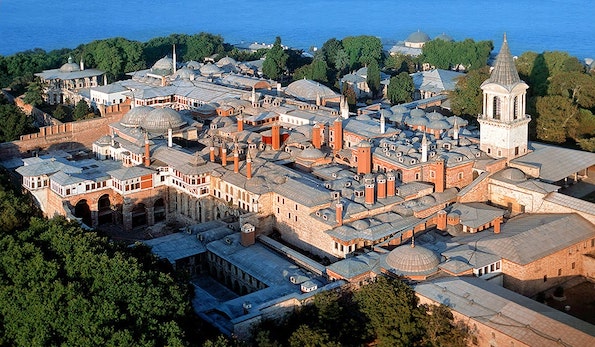The famous Topkapi Palace Museum is a huge complex of buildings covering 700,000 m2, made up of large courtyards, a section for the sultan’s harem and the palace. As a city within the city of Istanbul, it was fortified with a 2 km long wall on the sea side dating back to Byzantine times, while the Turks built another 1,400 km long wall on the mainland side, which forms the border between the complex and the city. It is located in the area of Cape Saw (Sarayburnu in Turkish), in a strategic position with easy access to both the European and Asian parts of Istanbul.
It was built in 1467 and Sultan Mehmet, who had conquered Istanbul, used it as his residence instead of living in the old palace, due to its convenient location. At first, Topkapi was used for official business and events while the harem was in the old palace from the 16th century AD, when the sultan moved the harem to the new palace as well.
You enter Topkapi Palace through the Imperial Gate (Bab-I Humayun) located behind Agia Sophia Church. An inscription on the gate informs visitors that it was erected in 1478, although some documents dating back to the 15th century indicate the construction of a pavilion with a tower above the gates, although it has not survived to this day. People had to pass the gate only on foot and never on horseback, except for ministers and viziers. The first call to prayer in the morning also meant the opening of the gate, which closed with the last prayer of the night.
After entering through the Imperial Gate, you come to the First Courtyard, which was used to house the Janissaries and to store wood and coal in barrels for heating. The church of St. Irene, one of the oldest in the world, is located in this same Patio and serves as an exhibition venue today. The First Courtyard is where cars and buses park today in order to let people into the other areas of Topkapi Palace. The next gate, at the end of the courtyard, is known as the Gate of Salutation (Bab-us Salem). It was erected in 1542 when its two towers were added in the 16th century.
Like the Imperial Gate, only viziers and important officials were allowed to pass through the Gate of Salutation on horseback. This allowed access to the Second Courtyard where the most important events of the Ottoman Empire, such as festivals, religious festivals, coronations of sultans etc, were held. These ceremonies could hold up to 10,000 people. The Second Courtyard was home to various animals (goats, deer, gazelles and others) in its cypress forests.
On the left, there is a path leading to the Council Meeting Hall (Kubbealyi), which the Divan Council used on Tuesdays. Decisions of the administration were made in that place: orders, feudal dues, deliveries, hearing complaints, signing decrees, negotiations with foreign authorities, and so on. There was a council room, a public records office and an office for the Grand Vizier. The council room was a rectangular room with low sofas (“divan” in Turkish) and thick carpets. In this hall there is a window behind grills where the Sultan secretly listened in on discussions. The two large towers above the Hall were used to observe the surroundings during Council meetings. All the documents relating to the sessions were kept in the records office. The third room was used as the Grand Vizier’s office.
From the Salutation Gate, there was a path to the sultans’ stables (Has Ahirlar), where there were around 30 high-quality racehorses. In the same area, there were two rooms used as the residence of the stable manager (Imrahor). A third path led to the palace kitchen, with around 800 stoves, where meals were cooked daily for almost 4,000 people. The building, which consists of ten vaulted rooms, was rebuilt in 1574 after being damaged by a fire.
The wide middle path from the Salutation Gate leads to another gate of Topkapi Palace, the Gate of Happiness and the Gate of the White Eunuchs (Bab-us Saadet). Dating back to the 15th century, it has a wide ceiling and leads to the Third Courtyard. Under the roof of this impressive gate supported by four columns, the sultan’s throne was placed for him to receive important visitors (foreign guests, ambassadors).
Passing through this gate leads to the Third Courtyard, where the Enderun is located. The Enderun is the place where the sultans lived their daily lives.
The great building of the Library of Ahmet III can be seen from this courtyard. It was built in the 18th century and is an excellent example of Turkish architecture.
O Quarto Patio abriga os apartamentos privados dos sultões. Além disso, tambem é onde se encontar a Mesquita Imperial Sofa construída em 1809. No centro do patio, é a residência do Médico-Chefe do palácio (Hekimbasi odası), habitada pelo químico do palácio, que controlava a preparação de medicamentos. Depois da Residência do Médico-Chefe, uma escada leva ao Pavilhão Terraço (Sofa Kosk), uma casa de madeira constituído por duas salas, erguida em 1703, e servindo como uma sala de repouso. Subindo mais uma escada, é o Pavilhão Revan (Revan Kosk), que é caracterizado por uma decoração impressionante. À direita, pode ver o Pavilhão de Bagdá (Bagdat Kosk), que foi usado como uma biblioteca.
Uma bela lareira decora o espaço interno deste Pavilhão. Uma pequena casa em frente ao Kosk Bagdat, servia para a circuncisão dos príncipes. Há uma varanda entre o Kosk Bagdat e a Casa da Circuncisão, conhecido como o Pórtico Iftar e situado à beira do terraço. Durante o mês do Ramadão, os sultões costumava ir lá para quebrar o jejum.


0 Comment